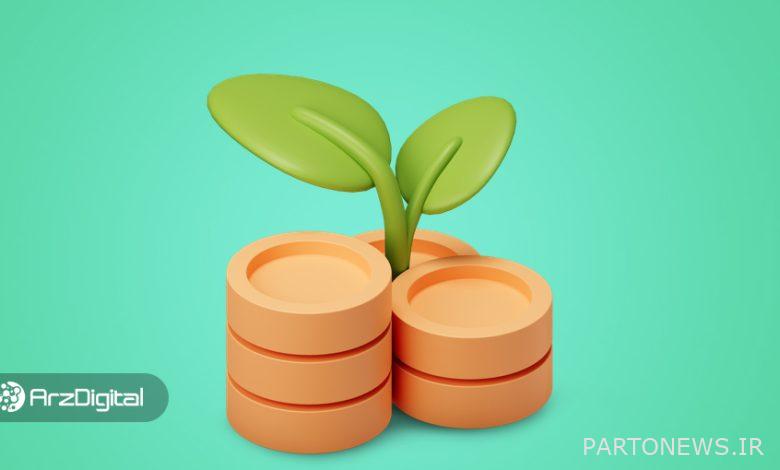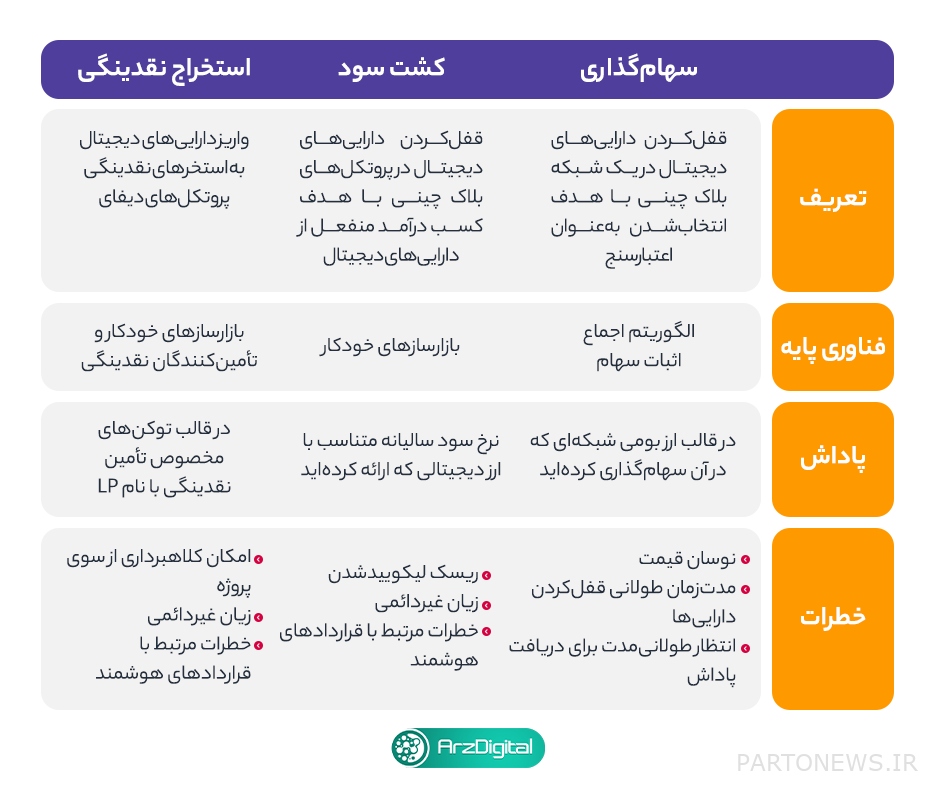Sharing, cultivating profits and extracting liquidity; Three popular ways to make a profit in Defai

Today, the world of digital currencies and DIFA subsidiaries have grown exponentially, and the opportunities for profit in DIFA have become so vast that they cannot be ignored. Now Defy has gone beyond a concept and found practical applications. Proponents of defaults are making money from it, and the idea of ”decentralized finance” is becoming a reality.
There are several ways to make a profit in Difa that are very similar and many newcomers may not be able to tell them apart. This can confuse those who want to invest in Difa. In this article, we are going to look at three popular ways to make a profit in Difai, namely equity and profit cultivation and liquidity extraction. These methods also have differences with each other, which we will mention in the present article; So stay with us until the end.
Three popular ways to make a profit in Defai
In Defy’s world, there are three popular ways to make a profit, called Staking, Yield Farming, and Liquidity Mining, that have caught everyone’s attention. The common denominator of these three Defai trading methods is that investors must pledge their assets in several ways to support a decentralized protocol or application; But the nature of each of these three paths is different.
Sharing (Staking) What is?
Sharing in the digital currency economy means depositing digital assets as collateral in those Chinese blockchain networks that use the Proof of Stake algorithm. Just as miners in proof-of-business blocks facilitate the consensus process, stock-proof blocks use shareholders to validate transactions and build blocks.
In general, because proof of stocks is more scalable and consumes less energy, it is more popular than proof of work algorithms. Proof of stock opens a window of opportunity for shareholders to make a profit. In proving stocks, each shareholder gets the chance to generate a block and get a reward for the coins he / she has invested.
The higher the number of coins invested, the higher the reward.
In the equity method, rewards are distributed in a chain or in a blockchain; That is, with the approval of each block, new tokens of that currency are issued and distributed among shareholders.
Today, equity is one of the most popular ways to make money from passive digital currencies and is even more popular than mining; Because there is no need for heavy investment to buy expensive equipment and allocate processing power. In addition, there are platforms in which equity is defined as a service and make the equity process simpler and smoother.
The risk of equity is lower than other methods of passive income, including profit cultivation. The token you are sharing belongs to the main platform itself and is just as secure; So you do not need to worry about the security of your assets.
What is profit cultivation?
In recent years, profit cultivation (Yield Farming) has become the most popular way to make a profit in defense. In this way, you can earn passive income by depositing digital currency in the liquidity pool. These liquidity pools are like centralized bank accounts to which you deposit money, and the bank uses it to lend to others and other businesses, and eventually pays you a portion of the income as interest.

In profit-making, investors lock their digital assets in a smart contract-based liquidity pool (such as the ETH / USDT). The investor’s locked assets are then made available to other users of the same protocol.
Profit cultivation forms the basis of defy lending platforms and enables their operation. It would not have been possible to develop these platforms without cultivating profits. In fact, it is the profit-makers who provide the liquidity for these platforms. They deposit their passive assets on lending platforms, and other users who need these assets borrow at a certain percentage of their interest. Part of this profit is paid to profiteers and a small part is given to the platform itself.
Profit makers can also guarantee the maintenance of digital currency liquidity in decentralized exchanges. This type of profit cultivation relies on automated market makers (AMMs), which replace order offices in centralized exchanges. Automated marketers are essentially smart contracts that use mathematical algorithms to facilitate the trading of digital currencies. Because these marketers do not need the other party to trade, the liquidity of the protocol is maintained and does not leave.
An automated market maker has two main divisions: Liquidity Providers (LPs) and liquidity pools.
- Liquidity pools: There are smart contracts that empower the market. These pools include digital funds that allow users to buy, sell, borrow, lend and exchange tokens.
- Liquidity suppliers: There are investors who pledge their assets in the liquidity pool and make a profit from it.
For tokens that have a small trading volume in the open market, profit cultivation is a lifeline for simple and easy trading.
Liquidity extraction (Liquidity Mining) What is?
Extracting liquidity means providing liquidity to decentralized exchanges and receiving rewards. This method is necessary for the continuation of decentralized exchange offices. As you know, decentralized exchanges are one of the main parts of Defy; Therefore, liquidity extraction is as important as the previous two methods for defa.

Decentralized exchanges rely on automated market makers (AMMs) to act as substitute for order offices in centralized exchanges. Automated marketers are basically smart contracts that use mathematical algorithms to facilitate the trading of digital currencies. Since decentralized exchanges are not run by a specific team, they are also funded by the users themselves. These users are called Liquidity Providers (LPs).
Liquidity suppliers deposit their digital currencies into the liquidity pool in the form of a currency pair (such as the ETH / USDT trading pair). The liquidity pool in return for these assets gives them a token called the Liquidity Provider (LP) token, which represents the digital assets locked in the pool. This token is finally needed to withdraw funds.
The reward percentage of liquidity providers is calculated based on their share of the total pool liquidity. For example, if their tokens make up 10% of the pool pool’s total tokens, they will receive a 10% pool-related bonus.
The difference between equity, profit cultivation and liquidity extraction
As we said at the beginning of this article, there are some differences between these three popular ways to make a profit in Difai, despite their similarities. The relationship between equity, profitability and liquidity extraction can be defined as follows:

Extraction of liquidity of profit cultivation sub-sector and profit cultivation of equity sub-sector Is.
However, we emphasize again that these three methods also have common points; Among other things, the goal of all three is to use users’ passive digital currencies, and they require collateral or locking up digital assets on a platform.
Conclusion
As you can see, digital currencies have now entered our real world and their applications have become so widespread that they can no longer be considered as mere means of paying or storing the value of capital. Currently, you can use digital currencies to borrow or lend your digital currencies to others. The profit you make from this loan can be much higher than the profit you get from depositing your assets in traditional banks.
Also, instead of using centralized exchanges and during the authentication process and worrying about new legislation, you can use decentralized exchanges. In these exchanges, you are both a user and a manager. Another point is that you can provide liquidity to these exchanges and receive rewards for this. In addition, you can validate, secure, and reward your digital currencies in China-based blockchain-based stocks and transactions.
In short, if you have some digital currency left in your wallet that you have nothing to do with, you may be able to choose one of the aforementioned ways to make money with a little research and training. Of course, whatever decision you make, you have to be careful about the money you earn. This article is by no means an investment recommendation and does not need to be repeated to say that digital currencies have their own risks. So before making any decision, it is better to research well and increase your information as much as possible.

